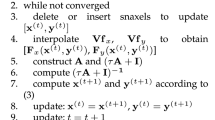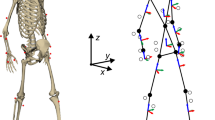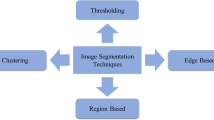Abstract
In this paper we present a comprehensive energy-based framework for the estimation and the segmentation of the apparent motion in image sequences. The robust cost functions and the associated hierarchical minimization techniques that we propose mix efficiently non-parametric (dense) representations, local interacting parametric representations, and global non-interacting parametric representations related to a partition into regions. Experimental comparisons, both on synthetic and real images, demonstrate the merit of the approach on different types of photometric and kinematic contents ranging from moving rigid objects to moving fluids.
Similar content being viewed by others
References
Adiv, G. 1985. Determining three-dimensional motion and structure from optical flow generated by several moving objects. IEEE Trans. Pattern Anal. Machine Intell., 7:384–401.
Ayer, S. and Sawhney, H.S. 1995. Layered representation of motion video using robust maximum-likelihood estimation of mixture models and Mdl encoding. In Proc. Int. Conf. Computer Vision, pp. 777–784.
Bab-Hadashiar, A. and Sutter, D. 1998. Robust optic flow computation. Int. J. Computer Vision, 29(1):59–77.
Barron, J., Fleet, D., and Beauchemin, S. 1994. Performance of optical flow techniques. Int. J. Computer Vision, 12(1):43–77.
Bergen, J., Anandan, P., Hanna, K., and Hingorani, R. 1992. Hierarchical model-based motion estimation. In Proc. Europ. Conf. Computer Vision, G. Sandini (Ed.), vol. 558 of LNCS, pp. 237–252, Springer-Verlag: Berlin.
Besag, J. 1986. On the statistical analysis of dirty pictures. J. Royal Statist. Soc., 48B(3):259–302.
Black, M. 1994. Recursive non-linear estimation of discontinuous flow fields. In Proc. Europ. Conf. Computer Vision, Stockholm, Sweden, pp. 138–145.
Black, M. and Anandan, P. 1996. The robust estimation of multiple motions: Parametric and piecewise-smooth flow fields. Computer Vision and Image Understanding, 63(1):75–104.
Black, M. and Jepson, P. 1996. Estimating optical flow in segmented images using variable-order parametric models with local deformations. IEEE Trans. Pattern Anal. Machine Intell., 18(10):972–986.
Black, M. and Rangarajan, A. 1996. On the unification of line processes, outlier rejection, and robust statistics with applications in early vision. Int. J. Computer Vision, 19(1):75–104.
Bouthemy, P. and Francois, E. 1993. Motion segmentation and qualitative dynamic scene analysis from an image sequence. Int. J. Computer Vision, 10(2):157–182.
Chang, M.M., Tekalp, A.M., and Sezan, M.I. 1997. Simultaneous motion estimation and segmentation. IEEE Trans. Image Processing, 6(9):1326–1333.
Charbonnier, P., Blanc-Féraud, L., Aubert, G., and Barlaud, M. 1997. Deterministic edge-preserving regularization in computed imaging. IEEE Trans. Image Processing, 6(2):298–311.
Cohen, I. and Herlin, I. 1999. Non uniform multiresolution method for optical flow and phase portrait models: Environmental applications. Int. J. Computer Vision, 33(1):29–49.
Corpetti, T., Mémin, E., and Pérez, P. 2000. Dense fluid flow estimation. IRISA, Technical Report No. 1352.
Delanay, A. and Bresler, Y. 1998. Globally convergent edge-preserving regularized reconstruction: An application to limited-angle tomography. IEEE Trans. Image Processing, 7(2):204–221.
Deriche, R., Kornprobst, P., and Aubert, G. 1995. Optical flow estimation while preserving its discontinuities: A variational approach. In Proc. Asian Conf. Computer Vision, Singapore, vol. 1, pp. 290–295.
Enkelmann, W. 1988. Investigation of multigrid algorithms for the estimation of optical flow fields in image sequences. Comp. Vision Graph. and Image Proces., 43:150–177.
Geman, D. and Reynolds, G. 1992. Constrained restoration and the recovery of discontinuities. IEEE Trans. Pattern Anal. Machine Intell., 14(3):367–383.
Hackbusch, W. 1985. Multi-Grid Methods and Applications. Springer-Verlag: Berlin.
Hellier, P., Barillot, C., Mémin, E., and Pérez, P. (2001). Hierarchical estimation of a dense deformation field for 3D robust registration. IEEE Transaction on Medical Imaging, 20(5):388–402.
Horn, B. and Schunck, B. 1981. Determining optical flow. Artificial Intelligence, 17:185–203.
Huang, Y., Palaniappan, K., Zhuand, X., and Cavanaugh, J. 1995. Optic flow field segmentation and motion estimation using a robust genetic partitioning algorithm. IEEE Trans. Pattern Anal. Machine Intell., 17(12):1177–1190.
Ju, X., Black, M.J., and Jepson, A.D. 1996. Skin and bones: Multi-layer, locally affine, optical flow and regularization with transparency. In Proc. Conf. Comp. Vision Pattern Rec., pp. 307–314.
Kornprobst, P., Deriche, R., and Aubert, G. 1999. Image sequence analysis via partial differential equations. Journal of Mathematical Imaging and Vision, 11(1):5–26.
Lai, S. and Vemuri, B. 1998. Reliable and efficient computation of optical flow. Int. J. Computer Vision, 29(2):87–105.
Leclerc, Y. 1989. Constructing simple stable descriptions for image partitioning. Int. J. Computer Vision, 3:73–102.
Mémin, E. and Pérez, P. 1998a. Dense estimation and object-based segmentation of the optical flow with robust techniques. IEEE Trans. Image Processing, 7(5):703–719.
Mémin, E. and Pérez, P. 1998b. Amultigrid approach for hierarchical motion estimation. In Proc. Int. Conf. Computer Vision, Bombay, India, pp. 933–938.
Mémin, E. and Pérez, P. 1999. Fluid motion recovery by coupling dense and parametric motion fields. In Int. Conf. on Computer, ICCV'99, pp. 620–625.
Mitiche, A. and Bouthemy, P. 1996. Computation of image motion: A synopsis of current problems and methods. Int. Journ. of Comp. Vis., 19(1):29–55.
Mumford, D. and Shah, J. 1989. Optimal approximation by piecewise smooth functions and associated variational problems. Comm. Pure and Appl. Math., 42:577–685.
Murray, D.W. and Buxton, H. 1987. Scene segmentation from visual motion using global optimization. IEEE Trans. Pattern Anal. Machine Intell., 9(2):220–228.
Musse, O., Heitz, F., and Armspach, J.P. 1999. 3D deformable image matching using multiscale minimization of global energy functions. In Proc. Conf. Comp. Vision Pattern Rec., Fort Collins, Colorado, vol. 2, pp. 478–485
Nesi, P. 1993. Variational approach to optical flow estimation managing discontinuities. Image and Vision Computing, 11(7):419–439.
Oisel, L., Mémin, E., and Morin, L. 2000. Geometric driven optical flow estimation and segmentation for 3d reconstruction. In Proc. Europ. Conf. Computer Vision, Dublin, Irland, and D. Vernon, (Ed.), vol. II, pp. 847–863. Springer Notes in Computer Science vol. 1843.
Samson, C., Blanc-Ferraud, L., Aubert, G., and Zerubia, J. 1999. Simultaneous image classification and restoration using a variational approach. In Proc. Conf. Comp. Vision Pattern Rec., Fort Collins, Colorado, vol. 2, pp. 618–623.
Schnorr, C., Sprengel, R., and Neumann, B. 1996. A variational approach to the design of early vision algorithms. Computing Suppl., vol. 11, pp. 149–165.
Schunck, B.G. 1986. The image flow constraint equation. Comput. Vision, Graphics, Image Proc., 35:20–46.
Stiller, C. 1997. Object-based estimation of dense motion fields. IEEE Trans. Image Processing, 6(2):234–250.
Szeliski, R. and Coughlan, J. 1994 Hierarchical spline-based image registration. In Proc. Conf. Comp. Vision Pattern Rec., Seattle, Washington, pp. 194–201.
Szeliski, R. and Shum, H.-Y. 1996. Motion estimation with quadtree splines. IEEE Trans. Pattern Anal. Machine Intell., 18(12):1199–1210.
Thisted, R.A. 1988. Elements of Statistical Computing. Chapman and Hall: London.
Viéville, T. and Faugeras, O. 1992. Robust and fast computation of unbiased intensity derivatives in images. In Proc. Europ. Conf. Computer Vision, S. Margherita Ligure, pp. 203–212.
Yezzi, A., Tsai, A., and Willsky, A. 1999. A statistical approach to image segmentation for bimodal and trimodal imagery. In Proc. Int. Conf. Computer Vision, Corfu, Greece.
Zhu, S. and Yuille, A. 1996. Region competition: Unifying snakes, region growing, and Bayes/MDL for multiband image segmentation. IEEE Trans. Pattern Anal. Machine Intell., 18:884–900.
Author information
Authors and Affiliations
Rights and permissions
About this article
Cite this article
Mémin, E., Pérez, P. Hierarchical Estimation and Segmentation of Dense Motion Fields. International Journal of Computer Vision 46, 129–155 (2002). https://doi.org/10.1023/A:1013539930159
Issue Date:
DOI: https://doi.org/10.1023/A:1013539930159




